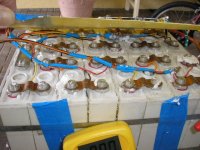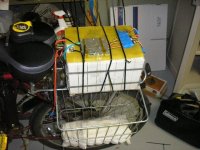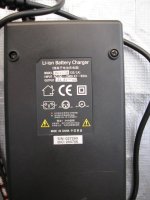mvadventure
1 kW
- Joined
- May 2, 2007
- Messages
- 419
I'm still trying to download pics and post but in the meantime I'm suffering a technical glitch.
The new LIPO4's have 26.3 miles on them. They started at 53.6 volts and are now at 50.6 volts and the charger isn't working!
Since it's the weekend I can't get hold of Zane. Here is what I know:
The charger is a Li-ion charger, Model JSC 1175A 13s/2A. The green charge indicator only comes on when it is plugged into the wall and not plugged into the battery. The fan does not run. There is no power when I plug a meter into where it is supposed to go into the battery. The inside of it shows no apparent damage and the little fuse tests good.
For what it's worth the SN is 027269 and the D/C is 200706.
After a 16.5 mile run yesterday th battery went from 53.2 to 52.6 which was great. A high speed run of 6.3 miles is the balance of mileage. The range appears as though it will be great if I can ever recharge them.
Any ideas on the charger? Can I use my SLA charger?
Mike
The new LIPO4's have 26.3 miles on them. They started at 53.6 volts and are now at 50.6 volts and the charger isn't working!
Since it's the weekend I can't get hold of Zane. Here is what I know:
The charger is a Li-ion charger, Model JSC 1175A 13s/2A. The green charge indicator only comes on when it is plugged into the wall and not plugged into the battery. The fan does not run. There is no power when I plug a meter into where it is supposed to go into the battery. The inside of it shows no apparent damage and the little fuse tests good.
For what it's worth the SN is 027269 and the D/C is 200706.
After a 16.5 mile run yesterday th battery went from 53.2 to 52.6 which was great. A high speed run of 6.3 miles is the balance of mileage. The range appears as though it will be great if I can ever recharge them.
Any ideas on the charger? Can I use my SLA charger?
Mike




